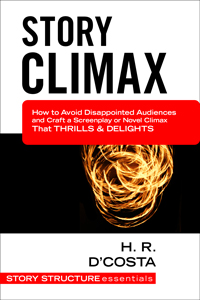You did, didn’t you?
You thought the hard part was over.
You’ve slogged through the middle of your story.
You’ve slaved over its beginning.
Now, it’s time to craft the climax.
The easy part, right?
Your protagonist only has to square off against his central antagonist.
From the moment you started your screenplay or novel, you had a rough idea of what was going to happen here. You could easily hold the images in your mind’s eye.
Your protagonist would trounce the bad guy; helicopters would definitely be involved.
Your hero would declare his love to the heroine on the steps outside of the courthouse—the very same one where her dad, now deceased, once presided as head judge.
You should be able to speed through this part of your story.
And, boy, do you want to.
You just want to finish this project.
Get it out to the marketplace.
Advance your career.
Make some money.
But, if you rush through the climax of your screenplay or novel, it could cost you.
Big time.
Act Three, it deserves as much attention as Acts One and Two…
(Maybe even more.)
See, the ending of your story has an additional burden to bear, one which the beginning and middle do not.
The ending is audiences’ last experience with your screenplay or novel. Their memories of it are the ones that really stick out in their minds.
Consequently, these are the memories they rely on most when making their final evaluations (thumbs down or up; recommended or not) of your story.
If the climax of your screenplay or novel is mediocre, it doesn’t matter how dazzling its beginning and middle are. Audience delight will–poof!–evaporate as they suffer through the lackluster finale that follows.
As a result, audience response to your story will be lukewarm at best, and hostile at worst.
That’s why it’s so important to know how to write a screenplay or novel with a spectacular ending, one that thrills and delights.
And this is where the rivalry between Roger Federer and Rafael Nadal comes in.
Do you remember their epic, five-set 2008 Wimbledon showdown?
This match was gripping to watch for two equally important reasons:
- Both tennis players were at the peak of their game.
- Both their peaks were of comparable levels—stratospherically high.
To drive this comparison home, let’s assign numerical values to each player’s peak, with 1 being the lowest, and 10 being the highest.
Hypothetically speaking, this championship match wouldn’t have been very thrilling if one tennis player had been at level 4, while the other had been at level 9. Barring a major upset, the player at level 9 would’ve mopped the floor with the other.
If both players had been at level 6, the final would’ve been more exciting than when their peaks vastly differed.
But, on the other hand, a match between players at level 6 isn’t half as interesting as when both players are at level 10.
For your climax to be exciting and entertaining…
…like Nadal and Federer, your protagonist needs to be well matched against a well-endowed antagonist.
If your protagonist is too strong, then he should quickly overcome his weak antagonist. Their climactic encounter will be over before it has a chance to really begin.
If your protagonist is too weak, it won’t be credible for him to defeat his antagonist, who’s much stronger. (And don’t think you can use deus ex machina to get your protagonist out of this pinch. That never works.)
Anyway, in either situation, your climax will be a huge disappointment.
And the results won’t be pretty.
You’re unlikely to sell your spec script to a studio.
Readers won’t be willing to take a chance on your next novel.
To avoid these unwanted consequences, make sure that your antagonist is a worthwhile adversary for your protagonist (and vice versa).
Take care not to favor one party over the other—a common amateur mistake.
Both should be intelligent, driven, resourceful (and, if necessary, physically strong).
They should be so well matched that the only reason audiences believe your protagonist will succeed is because they’re banking on the fact that most stories do, indeed, end happily.
But if not for this statistic, the outcome of your climax—like the 2008 Gentlemen’s Wimbledon Championships—would be in question.
That’s how you create a climax filled with tension and suspense.
That’s how you keep audiences at the edge of their seats.
So, how do you accomplish this?
How do you keep your protagonist and antagonist well matched?
Immediately prior to, or even in the midst of, the climax of your story, you could:
- handicap the protagonist by removing his mentor
- handicap the antagonist by removing his mass people
- fortify the protagonist through illusory mass people
Take a closer look…
Handicap the protagonist by removing his mentor
The presence of a potent mentor can make your protagonist’s side too strong, resulting in the flaws we discussed earlier. If the mentor participates in the climax, because he’s so powerful, the outcome of the climax will be a foregone conclusion—and a snooze fest.
At the other end of the spectrum, if the mentor doesn’t participate in the climax, his nonappearance will raise issues of credibility. If he’s still around, why didn’t he help the protagonists to fight the bad guy?
The solution, then, is to somehow remove the mentor from the picture prior to the climax, so he, quite plausibly, can’t participate in it.
Thus, the protagonist’s chances of success are reduced, which puts the how of the protagonist’s victory into question, paving the way for a more gripping finale.
The mentor doesn’t have to be killed, mind you; his removal can be effective even if it’s only temporary.
Take the Harry Potter series. Harry’s mentor, legendary wizard and Hogwarts headmaster, Albus Dumbledore, once subdued Voldemort. If necessary, Dumbledore presumably can vanquish Voldemort yet another time.
As long as Dumbledore is around, success is virtually guaranteed (especially in the early installments of the series when Voldemort is still in recovery mode).
Hence, if the climax is one Dumbledore can participate in, to make this pivotal plot point more enthralling, the films (and novels, obviously) go to great lengths to take Dumbledore out of the picture, enabling Harry to confront Voldemort mano a mano.
For instance, in the first film, THE SORCERER’S STONE, when Voldemort infiltrates Hogwarts (the castle, not the forest), Dumbledore is engaged in an errand that has taken him away from the school grounds. Since Dumbledore is not there to offer his protection to Harry and Harry’s friends, they must stop Voldemort themselves.
As other examples, study the first three films in the X-Men franchise. It’s no coincidence that in all of them, Professor Xavier is never able to use his considerable powers to assist the protagonists at the climax.
In the first, he is poisoned (rather hastily, I might add). In the second, he is taken captive, and put under mind control. Finally, in the third, he is killed—an outcome that not only yields a more effective climax but also a more compelling midpoint.
Handicap the antagonist by removing his mass people
Mass people?
Who are they?
As Linda Seger explains in Making a Good Script Great, they are supporting characters who “provide mass and weight to demonstrate the prestige, power, or stature of the protagonist or antagonist.”
Think of:
- henchmen
- freelance mercenaries
- bodyguards
- personal assistants
- crime techs
Returning to the climax of your story, to weaken your antagonist, and thus give your protagonist a shot at success, you can divest the antagonist of the mass people who, heretofore, reinforced his power.
In an action movie, this commonly equates to good guys killing off the villain’s henchmen prior to, or in the midst of, the climax. You could also arrange for the villain’s henchmen to:
- leave the villain’s side to prepare the villain’s getaway
- abandon the villain because they’re disgruntled with his leadership
- check on an unexpected problem—engineered by the protagonist for this very reason
Another option: have the villain eliminate his own henchmen (as Gabriel does in LIVE FREE OR DIE HARD). Even though the villain is divested of his mass people, and hence, is theoretically more susceptible to the hero, by emphasizing the villain’s ruthlessness, this choice paradoxically reinforces his power.
Taking the villain’s henchmen out of the picture is fairly easy. When your antagonist isn’t a villain per se, removing his mass people will require especially creative means.
As inspiration, examine the ending of 9 TO 5. Although the heroines have taken their nemesis, Franklin Hart, captive, his loyal administrative assistant, Roz, still poses a potent threat. Since she’s his “eyes, ears, nose, and throat,” she can jeopardize the heroines’ ruse, making Hart’s eventual victory inevitable.
Therefore, to handicap him, the heroines have to remove her.
Ingeniously, they fake a memo requesting that she journey to France to participate in a lengthy language immersion course. Filled with delight, Roz goes off to Europe. Equally delighted by the heroines’ ingenuity, audiences can’t wait to see what happens next.
Another clever (and comedic) use of mass people can be found in MEAN GIRLS. Regina George is so important, she even outsources her hugs through her friend (and minion), Gretchen. In this way, Gretchen reinforces Regina’s power.
As a matter of fact, as long as Regina has Gretchen and another friend/minion by her side, Regina’s impervious. She can’t be ousted as queen bee of North Shore High.
However, as Cady and her coconspirators conclude, Gretchen—when put under sufficient pressure—can “crack”; turn against Regina; and transform into a weakness, which can be exploited to Cady’s advantage.
This example illuminates an interesting point:
While mass people reinforce an antagonist’s power, ironically, they all also represent points of vulnerability which can, under certain conditions, be used to take down the antagonist.
Remembering this truth may be the very thing that helps you maintain the balance of power between your protagonist and antagonist at the climax of your screenplay or novel.
Fortify the protagonist through illusory mass people
Strengthen your protagonist by bolstering his power through illusory mass people: individuals who make the protagonist appear more powerful, but who, unbeknownst to the antagonist, don’t augment the protagonist’s position at all.
Think of that scene in ERIN BROCKOVICH (incidentally, not from the climax), when a trio of PG&E’s lawyers (“who look like Secret Service”), invades Ed’s law offices.
To make himself appear equally intimidating, Ed expands his own roster of personnel from a duo into a quartet. Cramming two staffers into his conference room, he boldly passes them off as lawyers employed by his firm.
Another great example of illusory mass people can be found in A FEW GOOD MEN, when Kaffee’s co-counsel arrives at the courtroom trial with two airmen in tow.
Blithely drawing Jessep’s attention to these airmen, Kaffee insinuates that they will provide testimony proving that Jessep is a liar. As Kaffee intended, this information unnerves Jessep and weakens this formidable foe.
As an added benefit, this tactic not only balances the power between your protagonist and his antagonist. It makes your protagonist, and by extension–you–look more clever to audiences!
Take your story climax to the next level…
…and join the ranks of novelists and screenwriters who are in demand.
You can be an “auto-buy” for thousands of readers.
You can be on Hollywood’s speed dial.
But, to accomplish these goals, you have to possess a very special writing skill.
You have to be like Harvey Specter on the TV show SUITS.
You have to be a “closer,” the kind of novelist or screenwriter whom readers and studios can count on to deliver an ending that isn’t merely satisfactory, but instead, deeply satisfying.

Balancing the power between your protagonist and his antagonist at the climax of your story is a great first step.
Even so, there’s additional ground to cover. One online writing article can’t contain all the answers, now can it?
If you’d like to learn more, please check out my writing guide, Story Climax: How to Avoid Disappointed Audiences and Craft a Screenplay or Novel Climax That Thrills & Delights.
It will teach you about:
- using 4 categories of antagonists and 8 rules of engagement to build your story climax on a sturdy foundation
- 2 criteria at the core of the climax that are crucial to fulfill to avoid disappointed audiences (but which, oddly, are often overlooked)
- 3 quality control tests your story climax must pass to earn audiences’ enthusiastic seal of approval
Buy Story Climax today and take a step closer toward making a living through your creativity!
Download the ebook instantly or buy the paperback
(free shipping with Amazon Prime):
Scales of Justice by Phil Roeder




















